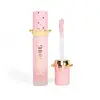What's inside
What's inside
 Key Ingredients
Key Ingredients

 Benefits
Benefits

 Concerns
Concerns

 Ingredients Side-by-side
Ingredients Side-by-side

Hydrogenated Polyisobutene
EmollientButyrospermum Parkii Butter
Skin ConditioningEthylhexyl Palmitate
EmollientOctyldodecanol
EmollientSynthetic Wax
AbrasiveParfum
MaskingLithospermum Erythrorhizon Root Extract
Skin ConditioningSorbitan Isostearate
Emulsifying1,2-Hexanediol
Skin ConditioningCaprylic/Capric Triglyceride
MaskingPersea Gratissima Fruit Extract
EmollientGluconolactone
Skin ConditioningMandelic Acid
AntimicrobialGlycerin
HumectantOrbignya Oleifera Seed Oil
EmollientEthylene/Propylene Copolymer
AbrasiveCaprylyl Glycol
EmollientEthylhexylglycerin
Skin ConditioningPalmitoyl Tetrapeptide-7
Skin ConditioningSphingolipids
EmollientWater
Skin ConditioningCeramide NP
Skin ConditioningLactic Acid
BufferingBenzyl Benzoate
AntimicrobialHydrogenated Polyisobutene, Butyrospermum Parkii Butter, Ethylhexyl Palmitate, Octyldodecanol, Synthetic Wax, Parfum, Lithospermum Erythrorhizon Root Extract, Sorbitan Isostearate, 1,2-Hexanediol, Caprylic/Capric Triglyceride, Persea Gratissima Fruit Extract, Gluconolactone, Mandelic Acid, Glycerin, Orbignya Oleifera Seed Oil, Ethylene/Propylene Copolymer, Caprylyl Glycol, Ethylhexylglycerin, Palmitoyl Tetrapeptide-7, Sphingolipids, Water, Ceramide NP, Lactic Acid, Benzyl Benzoate
Polyisobutene
Ethylhexyl Palmitate
EmollientCaprylic/Capric Triglyceride
MaskingHydrogenated Polyisobutene
EmollientOctyldodecanol
EmollientTridecyl Trimellitate
EmollientSilica Dimethyl Silylate
EmollientHydrogenated Styrene/Isoprene Copolymer
Diisostearyl Malate
EmollientParfum
MaskingPhenoxyethanol
PreservativeTocopheryl Acetate
AntioxidantPolyglyceryl-2 Triisostearate
EmulsifyingLimnanthes Alba Seed Oil
Skin ConditioningBis-Diglyceryl Polyacyladipate-2
EmollientCI 77891
Cosmetic ColorantCI 15985
Cosmetic ColorantCI 45380
Cosmetic ColorantPolyisobutene, Ethylhexyl Palmitate, Caprylic/Capric Triglyceride, Hydrogenated Polyisobutene, Octyldodecanol, Tridecyl Trimellitate, Silica Dimethyl Silylate, Hydrogenated Styrene/Isoprene Copolymer, Diisostearyl Malate, Parfum, Phenoxyethanol, Tocopheryl Acetate, Polyglyceryl-2 Triisostearate, Limnanthes Alba Seed Oil, Bis-Diglyceryl Polyacyladipate-2, CI 77891, CI 15985, CI 45380
Ingredients Explained
These ingredients are found in both products.
Ingredients higher up in an ingredient list are typically present in a larger amount.
This ingredient is an emollient, solvent, and texture enhancer. It is considered a skin-softener by helping the skin prevent moisture loss.
It helps thicken a product's formula and makes it easier to spread by dissolving clumping compounds.
Caprylic Triglyceride is made by combining glycerin with coconut oil, forming a clear liquid.
While there is an assumption Caprylic Triglyceride can clog pores due to it being derived from coconut oil, there is no research supporting this.
Learn more about Caprylic/Capric TriglycerideEthylhexyl Palmitate, also known as octyl palmitate, is created from 2-ethylhexyl alcohol and palmitic acid. It is a fatty acid ester.
The fatty acid content of Ethylhexyl Palmitate makes it an emollient. Emollients help soften and hydrate your skin by trapping moisture within.
Ethylhexyl Palmitate is also used to help improve the texture of cosmetics. It helps other ingredient dissolve in products and help disperse ingredients more evenly.
You'll likely find this ingredient in sunscreen, as it is often used to mix UV-blocking ingredients such as avobenzone and ethylhexyl triazone.
It can also help stabilize the fragrances in a product as a fragrance fixative.
Ethylhexyl Palmitate can be used to substitute mineral oil.
Due to its high fatty acid content, it may not be fungal-acne safe.
Learn more about Ethylhexyl PalmitateHydrogenated Polyisobutene is a synthetic polymer. Polymers are compounds with high molecular weight. Hydrogenated Polyisobutene is an emollient and texture enhancer.
In one study, Hydrogenated Polyisobutene showed better skin hydration levels than Caprylic/Capric Triglyceride. As an emollient, it helps keep your skin soft and hydrated by trapping moisture in.
Hydrogenated Polyisobutene is often used as a mineral oil replacement.
Learn more about Hydrogenated PolyisobuteneOctyldodecanol is a fatty alcohol. It is primarily used to enhance the texture of products.
As an emulsifier, Octyldodecanol helps prevent the oils and waters from separating. It also prevents ingredients from creating foam when shaken.
Octyldodecanol is created by reducing fatty acid to an alcohol.
Due to its high molecular weight, it does not get absorbed into the skin.
Learn more about OctyldodecanolParfum is a catch-all term for an ingredient or more that is used to give a scent to products.
Also called "fragrance", this ingredient can be a blend of hundreds of chemicals or plant oils. This means every product with "fragrance" or "parfum" in the ingredients list is a different mixture.
For instance, Habanolide is a proprietary trade name for a specific aroma chemical. When used as a fragrance ingredient in cosmetics, most aroma chemicals fall under the broad labeling category of “FRAGRANCE” or “PARFUM” according to EU and US regulations.
The term 'parfum' or 'fragrance' is not regulated in many countries. In many cases, it is up to the brand to define this term.
For instance, many brands choose to label themselves as "fragrance-free" because they are not using synthetic fragrances. However, their products may still contain ingredients such as essential oils that are considered a fragrance by INCI standards.
One example is Calendula flower extract. Calendula is an essential oil that still imparts a scent or 'fragrance'.
Depending on the blend, the ingredients in the mixture can cause allergies and sensitivities on the skin. Some ingredients that are known EU allergens include linalool and citronellol.
Parfum can also be used to mask or cover an unpleasant scent.
The bottom line is: not all fragrances/parfum/ingredients are created equally. If you are worried about fragrances, we recommend taking a closer look at an ingredient. And of course, we always recommend speaking with a professional.
Learn more about Parfum